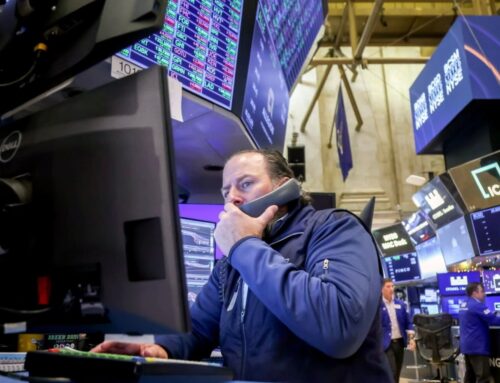Are Amazon’s Warehouses Facing an ‘Injury Crisis’?
May 19, 2025
George Clarke, an Amazon warehouse worker in New Jersey, could barely hide his emotions.
“Amazon will tell you that outside groups are misrepresenting their injury record, but in fact, Amazon is misrepresenting their injury record,” he said at an investor briefing organized by the Interfaith Center on Corporate Responsibility, a New York-based coalition of faith- and values-based investors, on Thursday. “I am not part of any outside group. I’ve been at Amazon for almost six years as a warehouse employee. I received employee of the month. As a Nodal Onboarding Academy trainer, I have received numerous accolades for my teaching abilities. I also received from Amazon a permanent physical disability.”
Clarke had injured his ankle in January 2023 while connecting air and electrical lines to a trailer. Despite a ruptured tendon, his manager directed him to AmCare, Amazon’s in-house first aid clinic, three times a day to ice his foot. He did this between his rounds for two weeks, walking a mile a day, up to 40 hours a week. When Amazon finally gave him the green light to see Amazon’s doctor, which he said only happened because he threatened to contact a lawyer, Clarke was sent to get X-rays and MRIs, given a boot to wear and told to restrict movement to no more than three hours a day. Still, he was told to return to work, he said.
“By July, I ended up in the emergency room, a doctor put me in a three-quarter cast and an orthopedic surgeon looked at my X-rays and my MRIs and said I could justify surgery tomorrow,” Clarke said. “I finally had the surgery on Jan. 9, almost one year after the date of injury, even then, Amazon dragged their feet. It took a court order in May of 2024 to cover my physical therapy and pain management docs. They didn’t pay my workers’ comp until July. To this day, workers’ comp has yet to reimburse me over $3,500 of medical bills.”
Despite this and what he says have been clear acts of retaliation, including removing some shares of the Amazon stock he earned, Clarke considers himself one of the lucky ones. Tens of thousands of the e-tail juggernaut’s workers, he said, are getting hurt in its fulfillment centers each year. He said that Amazon’s emphatic rejection of reports of safety shortfalls at its warehouses—described in its 2025 proxy statement as based on “false, misinformed and misleading claims” made by “outside groups with ulterior motives”—doesn’t correspond with his experience, nor those of other members of the Warehouse Life community to which he belongs.
“Amazon’s strategy is simple,” Clarke said. “To delay until the injured party either runs out of money or gives up, goes back injured or goes on disability, letting Amazon off the hook. All of this isn’t just immoral; it’s a legal, reputational and financial risk. We’re not outsiders, and we’re telling the truth.”
The briefing arrived ahead of the Everything Store’s annual meeting on Wednesday, when shareholders will be voting on nearly a dozen proposals, including one requesting an independent audit and report of the working conditions and treatment of warehouse workers. The board has recommended voting against this, saying it would be duplicative of existing efforts, including its own public disclosures.
“Our goal is to be the global benchmark for safety excellence across all industries in which we operate,” Amazon said. “We provide a safe, clean and healthy work environment, and the health, wellness and safety of our teams is our top priority. We have implemented robust practices and procedures for reporting and preventing accidents, injuries, and unsafe conditions or behaviors. We develop initiatives to support the well-being of our workforce, offering learner-centered safety training and investing in technologies, controls and solutions to reduce and eliminate safety risks for our teams.”
Pointing to its latest safety report, it added that Amazon’s worldwide recordable incident rate improved by 35 percent and its worldwide lost time incident rate by 65 percent between 2019 and 2024, demonstrating that it has “made meaningful and measurable progress” over the years.
But the Strategic Organizing Center, a coalition of North American labor unions, disagrees. In a report published Thursday, the same day that Clarke and other Amazon employees provided testimonies of what they went through, SOC said that four in 10 Amazon workers in the United States worked in facilities where the recordable injury rate increased between 2023 and 2024.
As of 2024, in fact, the Whole Foods owner’s injury rate remains more than 80 percent higher than its goal to halve its workplace recordable incident rates by 2025, becoming “Earth’s safest place to work.” Amazon’s serious injury rate, the report added, is also nearly twice as high as other companies in the warehouse industry, showing a “near-total failure on the part of Amazon’s management to address its injury crisis.”
Based on data submitted to the Occupational Safety and Health Administration, Amazon’s fulfillment operations continue to be “dramatically more dangerous” for workers than the rest of the industry, SOC said, with a 2024 injury rate that was 5.9 per 100 workers, almost double that of the 3 per 100 in non-Amazon warehouses. While the Prime Day operator employed 39 percent of all U.S. warehouse workers in 2024, it was also responsible for more than half—that is, 56 percent—of all serious injuries in the industry, the organization added.
“In 2023, we analyzed Amazon’s injury data to track when the most injuries occurred, and we found that the company reports major spikes in total injuries around its peak sales period, including Prime Days and the holiday shopping period,” said David Rosenblatt, SOC’s deputy director of strategic research and campaigns.
“Internal documents from Amazon show that the company has known about this problem for many years, yet in 2024, we found that the injury spikes are nearly the same as they were in 2023, which shows that Amazon has utterly failed to take meaningful steps to prevent injuries during its peak periods,” he added. “Amazon is a company that prides itself on using data to relentlessly improve its operations, but it’s hard for us to imagine any other area of Amazon’s business in which a failure of this magnitude would be allowed to continue for years.”
While Amazon didn’t respond to questions about the veracity of Clarke’s testimony, as well as those of others from the webinar, it accused SOC of misleading readers by “cherry-picking data and making up a metric that doesn’t exist” in the form of “serious injury rates,” which it said “isn’t used by industry professionals.”
“Our goal is to be the safest employer in our respective industries, and we’re working hard to achieve that because nothing’s more important than our employees’ health and safety,” it said. “In 2025, we’ve allocated hundreds of millions of dollars, on top of the more than $2 billion we’ve invested over the past five years, to invest in technologies, resources, training, and programs to further our safety efforts. The best way to understand the facts is to read our latest safety report.”
Injuries aren’t all that Amazon has had to contend with, however. Tommy, who didn’t give his last name, said that his brother-in-law, Rodger Boland, died after falling and hitting his head in an overheated New Jersey warehouse in July 2022.
“He was found by colleagues who noticed he wasn’t breathing,” he said. “They gave immediate CPR, three cycles, he began breathing, and then they were instructed by a supervisor to lift him up and put him in a chair. EMTs, police were dispatched.”
The problem, Tommy said, was that when EMTs finally arrived, they were left waiting at the gate for 10 to 15 minutes. When they were allowed in, they were denied entry to the door closest to Boland because it was “for emergencies only.” A police officer began arguing with security, but the door remained closed, forcing the EMTs to round over to an entrance on the opposite side of the building, which they estimated was half the size of a football field, and then walk through the entire warehouse. Boland was transported in critical condition to the nearest hospital, where he was pronounced dead.
“After that, I start calling around, first of all, to the hospital. They wouldn’t give me any information because of HIPAA, so I then contacted Amazon,” Tommy said, using an acronym for the health privacy law. “After numerous attempts, I finally was able to contact the head of their AmCare at the facility. I also contacted the supervisor at HR. They gave me very little information, but what they did say was that they both understood that Rodger had had a history of seizures throughout his life. This was completely false. Rodger had never had a seizure. Rodger was married to my sister for 46 years at the time, and I don’t know that Rodger was ever in the hospital, and he was always a very healthy person.”
Tommy said that Amazon has never tried to contact his sister, save for a letter informing her it was planting a tree in Boland’s memory. Any attempt to gather information about death benefits, or anything like that,” has gone unanswered, he said. “She’s still not over the whole thing. She’s not over the fact that Amazon reacted so coldly.”
Connor Spence is the president of the Amazon Labor Union at the JFK8 warehouse on Staten Island in New York City, which overwhelmingly voted to organize in 2022 but has been unable to sit down at the bargaining table with the retailer despite the National Labor Relations Board upholding its results. He said that workers are finding more reasons every day to join the fight that JFK8 and others are waging at their fulfillment centers.
“Last month, a worker was killed on the job, and the response from the company was, to begin with, a complete rush to reopen the warehouse,” he said. “They could not get operations back up and running fast enough. [There was] zero transparency around the incident, what caused it, what things are going to be remedied in order to address the failures in the process that led to this in the first place. And I’ll just say that if your goal is to create unrest amongst the workforce, if your goal is to make it difficult for production to happen, then showing a basic disrespect for human life is a good way to do it.”
Spence said that workers know how to address these safety issues because they see them every day. The problems are far from insurmountable, he said, and Amazon Labor Union has been waging a campaign centered around what he described as unsafe staffing levels, an equally untenable pace of work with too-short rest breaks, and inhumane conditions that include 10-to-12-hour shifts in sweltering temperatures during the summer months.
“It’s not a mystery to the company what these problems are, and if they were to negotiate with us, the workers, we would have a fair and constructive process by which we could make these changes,” Spence said. “We could bring down the injury rates, and we could ultimately, between the workers and the investors and the company, make sure that the business is healthy and able to be productive, because at the end of the day, we have a stake in this business as well.”
Investors have continued to flag these issues, said Renaye Manley, senior advisor to the Capital Markets Hub Project, sponsored by the Amalgamated Bank Foundation. Manley is one of the co-sponsors of the shareholder proposal to shed more light on warehouse conditions. She said that what she and others want to know is how Amazon’s long-term sustainability is being impacted by its labor practices, which “raise red flags about risk oversight and board accountability on issues around human capital management.”
“We’ve called for greater transparency, better board oversight and meaningful reforms to workforce management policies,” she said. “The reputational, regulatory and operational risk associated with continued inaction are not abstract. They are very real, they are growing and they need to be addressed.”
Complaints about Amazon’s occupational safety have also reached Capitol Hill, where the Senate Committee on Health, Education, Labor and Pensions led an 18-month-long investigation that concluded that Amazon was masking injury rates that were “significantly” higher than both the industry average and non-Amazon warehouses because it was sacrificing worker well-being for the sake of increasing productivity.
“Amazon forces workers to operate in a system that demands impossible rates and treats them as disposable when they are injured,” Senator Bernie Sanders, an Independent from Vermont, said in December following the release of the findings. “It accepts worker injuries and their long-term pain and disabilities as the cost of doing business.”
When Sanders said that it was Amazon that was cherry-picking data to appear “nearly as safe” as its peers, Amazon immediately pushed back, saying that the committee’s conclusions were “fundamentally flawed” because they were based on “outdated information that lacks context and isn’t grounded in reality.” It repeated that assertion in its proxy statement by pointing to the title of the report: The ‘Injury-Productivity Trade-off’: How Amazon’s Obsession with Speed Creates Uniquely Dangerous Warehouses.”
“If that premise were accurate, injuries would increase as productivity and speed increase,” Amazon said. “In fact, however, our experience over the last five years has been exactly the opposite—we have increased our delivery speeds, while decreasing the injury rates across our network. Our strong policies—and adherence to them—are helping us create a safer work environment.”
Rosenblatt isn’t convinced. He said that Amazon is trying to shape a public narrative that “basically distracts from the real stories that workers are experiencing,” while giving the “false impression that there either isn’t a problem or the problem is being addressed.” SOC, he said, has even filed a complaint with the Securities and Exchange Commission about what he says is the retailer’s “misleading communication” to shareholders.
“For example, Amazon prefers to compare itself against a segment of the warehouse industry that is warehouses that have more than 1,000 employees,” he said. “Amazon itself makes up 80 percent of the employment in this category, and so by choosing this very specific benchmark for its performance, Amazon is effectively comparing its own performance with itself. There’s many other examples that illustrate how the company is trying to put a positive spin. The real story is the one workers experience themselves.”
Search
RECENT PRESS RELEASES
Related Post



